
WHAT IS IT?
The all-new fourth generation of Mazda’s hugely popular small car, offered in both sedan and hatch. They are powered by (very) mildly updated versions of the SkyActiv G petrol four-cylinder engines, in 2.0- and 2.5-litre capacities. Both body styles are larger than the models they will replace when launched in Australia around May, but this doesn’t translate to increased cabin space.

WHY ARE WE DRIVING IT?
The significance of the 3 to the Australian market – it’s continually up the very pointy end on the best-seller list of passenger cars – meant our attendance was a no-brainer. The international launch was held in Los Angeles, a mega city with some great roads not far from its congested freeways.
THE WHEELS REVIEW
Who knew, after all these years, there was one easy explanation – Mazda just wasn’t trying hard enough. Okay, that’s a slightly simplistic and fairly uncharitable conclusion to draw when it comes to dissecting the NVH afflictions that have marred the company’s small car for three generations.

But perhaps there is a kernel of truth there, despite its huge sales success. See, zesty performance and keen dynamics have always pushed the 3 to at least podium positions in our small-car rankings. It’s mostly been raucous road noise and a bit of upper-rev uncouthness that have tempered our enthusiasm for the 3, especially against the silken refinement of VW’s evergreen Golf.
But for this fourth generation, due in Australia around May or June, all that has changed. By declaring all-out war on road noise – including the use of a new production process that sees sound-damping ‘nodes’ sandwiched between key sheetmetal sections before spot-welding takes place – Mazda has delivered a small car that not any rides and drives with a maturity that could be from the class above, it also seems likely to challenge the Mk7 Golf for refinement honours.

Our drive out of Los Angeles took in suburban streets, slab-section freeways and some enjoyable twisty bits up in the mountainous Angeles National Forest above the glittering metropolis. On just about every level, the new 3 deeply impressed. But it’s the quietness and overall refinement which really feels to have made the biggest leap.
The all-new platform delivers a slightly larger car riding on a wheelbase that’s 25mm longer that the outgoing model, but this hasn’t translated into any appreciable gain inside the cabin. Sitting behind the driver’s seat set for my six-foot frame, rear head- and legroom is adequate, nothing more. If rear seat space is a high priority, you may be better off at a Honda dealership looking at the commodious Civic.
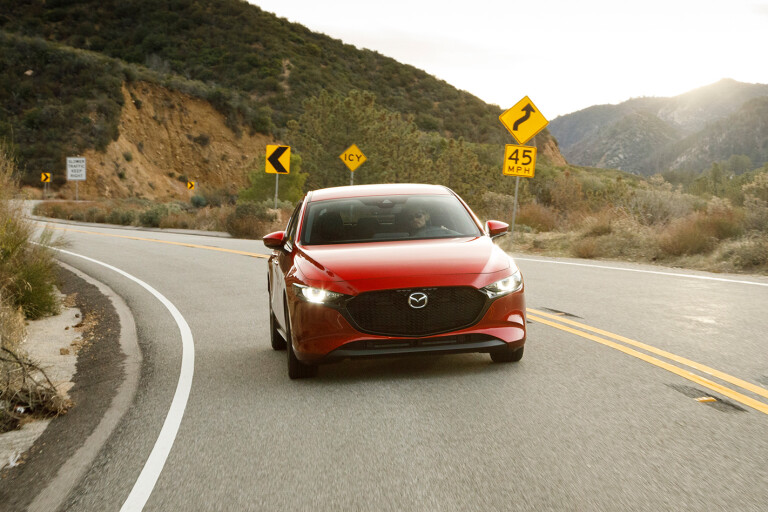
Eyebrows may also spike skyward at the news that Mazda has ditched in the independent rear suspension of the outgoing car in favour of a simpler, cheaper, (and also lighter) torsion-beam arrangement. But it’s a more sophisticated take on the basic twist-beam design, utilising steel of differing thickness to aid chassis tuning, and is sufficiently removed from existing hardware to have a patent pending. Chassis engineers insist that in the real world, it’s not inferior to the multi-link layouts used in this class.
As best we can establish, the move away from IRS was essential for the packaging requirements needed for the lithium-ion battery pack fitted to the mild-hybrid version –a (for now, at least) not-for-Oz model which uses a belt-driven integrated starter generator (ISG) set-up to boost torque by a claimed 12Nm. For those counting litres, boot space in the hatch has actually dropped slightly (was 308 litres; now back to 295L), so no, the new model is not exactly a masterclass in packaging genius.
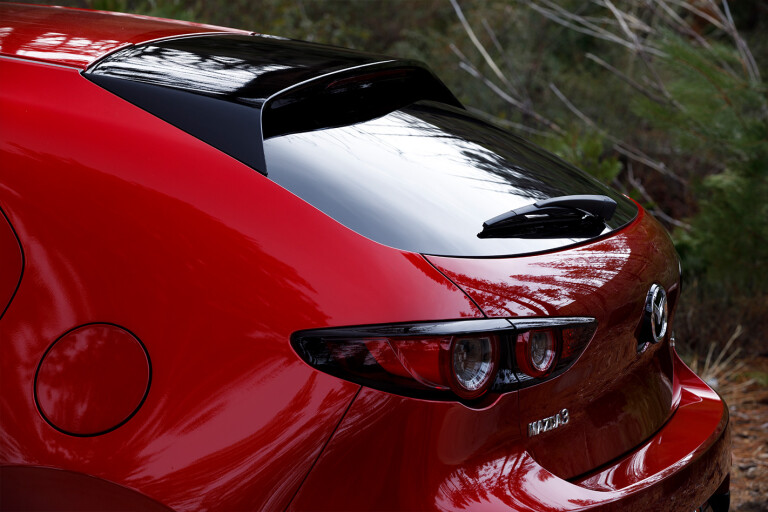
But enough of the tech dive, because the central message that Mazda is pushing with the new 3 – and more broadly from here on it, it seems – is one about human-centric design. That is, putting the human form – and the way people sit, bend, see, and generally function while driving or riding in a car – at the forefront of every design decision. Sounds logical, but Mazda are trumpeting this as something of a breakthrough. The front seats in the upspec cars we drove are claimed to position occupants better than the outgoing car, even if we are told the hip point remains much as it was.
What I did notice straight away is that for my XL frame, the front seats are instantly more comfortable and supportive than those in the top-spec Mazda 6 Atenza I recently drove. The driving position feels spot-on, with dead-pedal and throttle in auto cars placed shoulder-width apart, and the steering column now provides an extra 20mm (for a total of 70mm) of reach adjustment, allowing taller drivers to pull the wheel in closer.
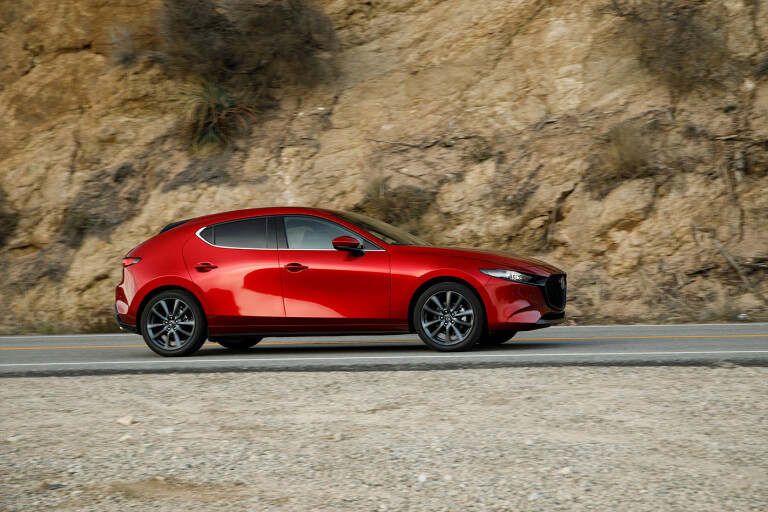
The instrument panel, HVAC controls and centre console appear far less cluttered – a reduction in “visual noise” is how Mazda describes it – with greater practicality evident in things like the dual cup holders forward of the shifter, and a generous bin ahead of that for phone or sunnies. The multimedia screen is larger – now 8.5 inches – and positioned slightly further away from the driver to reduce the eye-focusing time from the road ahead to the display. Mazda has also bucked the touch-screen trend, claiming it’s safer for drivers to navigate the improved system via the larger rotary controller just aft of the gear lever. Okay, but we bet any teenagers in the passenger seat using the standard-fit Apple Car Play or Android Auto will poke at the unresponsive screen more than once.
Less divisive are the revamped and better explained functions within the various menus, as well as the improved head-up display for top spec models, which ditches the pop-up plastic reflector thing for a more integrated and sophisticated projector system. Eyes-ahead clarity for navigation, and speed-sign recognition is excellent. And you’ll instantly note the move to better quality materials pretty much everywhere, from the stitched dash top in upper-spec models, padded lid of the generous console box, as well as the uniform slickness and tactility of every button and switch. Even the warning chimes and the indicator’s ticking sound have been acoustically buffed in the quest for “added premiumness.” It’s a convincing effort, and sadly for the likes of the Ford’s all-new Focus and even Toyota’s Corolla, leaves those rivals in a world of scratchy-plastic hurt.

As for on-road dynamics, this is a core zone of excellence that may see the 3 throw down a serious challenge to the segment-leading Focus. It will take a comparo to reveal it as fact, but I suspect the 3’s steering is not too far short of the Ford’s brilliant set-up. Mazda has wisely ignored multiple modes, instead providing one fixed setting that begins with a natural, medium weighting at manoeuvring and parking speeds, which doesn’t change dramatically when on the move. It’s gifted with an oily slickness that never feels gluggy or viscous, and has a just-right return rate when self-centring out of a roundabout, for example. At freeway speeds it’s relaxed but not aloof, while in the twisty stuff, it never loads up excessively, and almost fades into the background to allow you to fully concentrate on exploring the chassis balance.
Which, we are happy to say, retains that pointy, engaging quality that Mazda has now built into its DNA. You’ll lap up the precision with which you can place the nose when pushing on, then smile at the progression of both adhesion breakaway and tail’s keenness to get in on the story arc. Admittedly the sedan we drove was fitted with 18-inch all-season Toyo rubber, so the speeds at which this was all happening was not exactly hot-hatch velocity, but still, there’s no denying that the 3 has involvement and adjustability oozing from its pores.
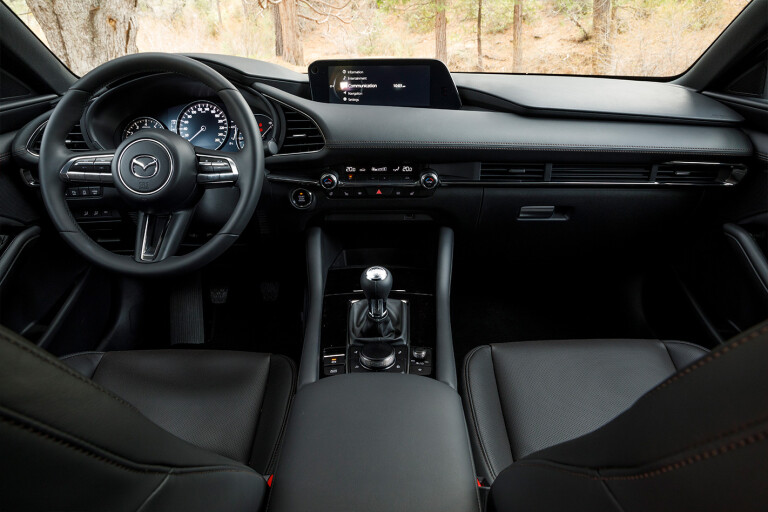
In the hatch, which was on regular summer-spec spec 215/45R18 Toyo Proxes A40s (representative of what Oz cars will run), there was more chassis grip and goodness to tap into, even if the Euro-spec (read, emission capped) 2.0-litre engine we drove, with just 90kW/ 213Nm, had a top-end weaker than prison coffee.
The 2.5-litre was obviously zestier and more fun, but the fact is that the two engines currently offered in the outgoing 3 carry over with only a bunch of combustion-efficiency changes, leaving the 2.0-litre with unchanged outputs (114kW/200Nm) and minuscule gains for the 2.5 (now 139kW/252Nm.
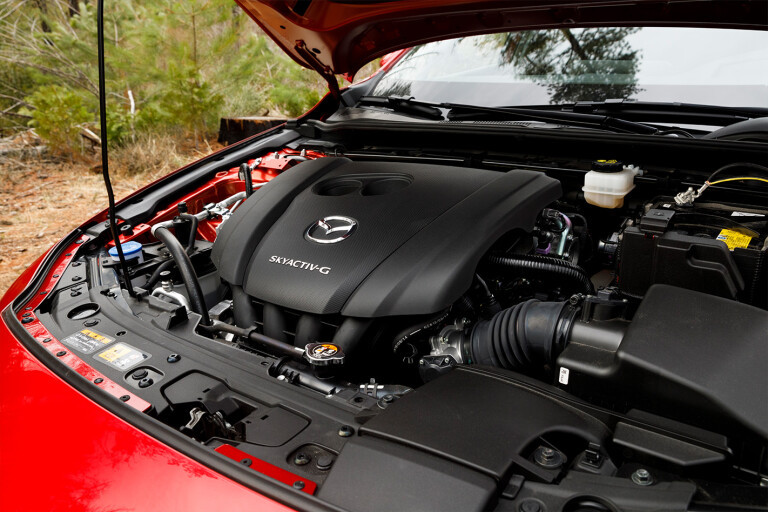
Yes, those torque figures, both delivered at 4000rpm, aren’t the most muscular numbers getting around this class. For improvements you’ll need to wait for the potentially game-changing SkyActiv X engine, with supercharger and compression-ignition technology, is not due until Q3 of this year. Some buyers will no doubt be tempted by the gruntier midranges delivered by the turbo-fed Golf or Focus. But those who do stick with the 3 will be rewarded with crisp, linear throttle response, and superb suppression of unwanted engine noise, so chasing revs is no chore. From inside the cabin, it sounds as though Mazda has doubled the firewall thickness for this generation, only allowing a cultured, distant timbre of mechanical harmony to make it to your ears.
Both transmissions are also excellent. Any 3 buyer seeking extra driver connection and reduced cost of entry will be rewarded with a beautifully slick, precise shift action through the six manual ratios, paired with near-perfect clutch weight and throttle tip-in.
The auto, meanwhile, has had both mechanical upgrades and a raft of software changes to improve both response and refinement. In Sport mode, it manages two seemingly contradicting qualities, being both eager to drop one or more ratios in response to throttle kick-down, yet does it with a cushioned softness that eliminates any jerkiness or shift shock. The prospect of this transmission, with paddle shifters, paired with the predicted grunt and linearity of the SkyActiv X engine, is properly tantalising.

Which is pretty much the over-arching take-out on the new 3 – a comprehensive ticker of boxes marked refinement, dynamics, ride comfort, cabin quality and design. Only the question of engine strength stops it short of a clean sweep, and that seems certain to be addressed when the new donk drops around October. Mark your calendar.
THE WHEELS VERDICT
Vastly improved over the outgoing third-gen model, and now a deeply impressive, ultra-well-rounded small car. Refinement takes the biggest leap forward, but the new 3 also comprehensively ticks the boxes for dynamics, ride comfort, cabin quality and style. Only the lack of packaging advantages from the bigger body and the question of engine strength stops it short of a clean sweep. The latter seems certain to be addressed when the new SkyActiv X petrol engine, with strong torque thanks to revolutionary combustion technology, is offered around October.

PLUS: Maturity; refinement; engine smoothness; steering; handling; cabin comfort and presentation; equipment in top spec
MINUS: Larger but not roomier than outgoing model; engines lack turbo-fed midrange punch; no vents or USB ports for rear-seat passengers; no digital speedo for models without head-up display
SPECS
Model: 2019 Mazda 3 SP25 Astina hatch
Engine: 2497cc 4cyl, dohc, 16v
Power 139kW @ 6000rpm
Torque 252Nm @ 4000rpm
Transmission 6-speed automatic
Weight: 1350kg (estimated)
0-100km/h: 7.9sec (estimated)
Price $36,000 (estimated)
Onsale May (estimated)

COMMENTS